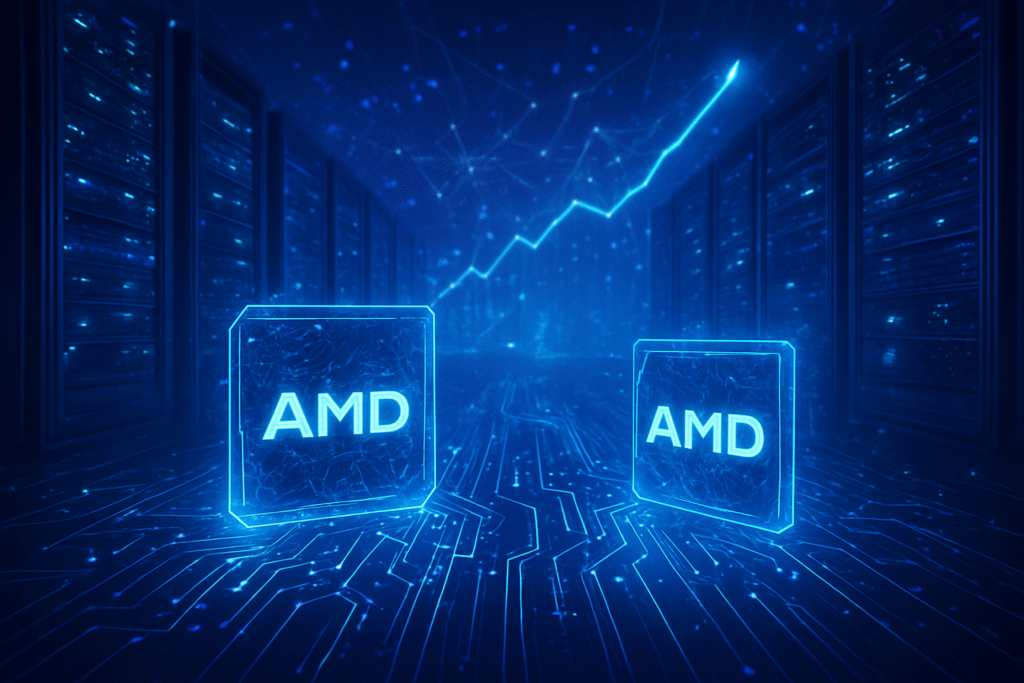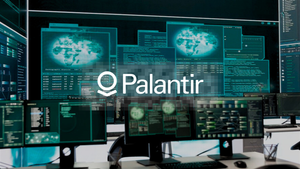
Sunnyvale, CA – November 11, 2025 – Advanced Micro Devices (NASDAQ: AMD) is rapidly solidifying its position as a preeminent growth stock in the semiconductor industry, driven by an aggressive expansion into the burgeoning artificial intelligence (AI) market and robust financial performance. With ambitious projections for future earnings per share (EPS), revenue, and data center segment growth, AMD is increasingly viewed as a formidable challenger to established giants and a pivotal player in shaping the future of high-performance computing and AI infrastructure.
The company's strategic pivot and technological advancements, particularly in AI accelerators and high-performance CPUs, have captured significant investor and analyst attention. As the global demand for AI processing power skyrockets, AMD's innovative product roadmap and crucial partnerships are positioning it for a period of sustained, exponential growth, making it a compelling case study for market leadership in a rapidly evolving technological landscape.
Unpacking AMD's Financial Trajectory and Strategic AI Onslaught
AMD's recent financial performance paints a clear picture of a company in ascendance. For the third quarter of 2025, AMD reported record revenue of $9.2 billion, marking a substantial 36% year-over-year increase. Non-GAAP diluted earnings per share (EPS) for the same period reached an impressive $1.20. A primary engine behind this growth was the data center segment, which saw revenue climb to $4.3 billion, a 22% year-over-year surge, fueled by strong demand for its 5th Gen AMD EPYC processors and the cutting-edge AMD Instinct MI350 Series GPUs. Looking ahead, the company has provided an optimistic outlook for the fourth quarter of 2025, projecting revenue of approximately $9.6 billion, representing about 25% year-over-year growth and a non-GAAP gross margin of around 54.5%.
The technical prowess of AMD's AI accelerators is central to its growth narrative. The Instinct MI325X, launched in October 2024, boasts an impressive 256GB of HBM3E memory and a memory bandwidth of 6 TB/s, demonstrating superior inference performance on certain AI models compared to competitors. This positions the MI300 series as a viable and cost-effective alternative to NVIDIA Corporation's (NASDAQ: NVDA) dominant offerings. Furthermore, AMD's next-generation MI400 series of AI chips, slated for a 2026 launch, promises variants tailored for scientific applications and generative AI, alongside a complete server rack solution, indicating a comprehensive strategy to capture diverse segments of the AI market.
AMD's strategic partnerships are equally critical. In a landmark announcement in October 2025, AMD secured a multiyear deal with OpenAI, committing to supply six gigawatts of its AI processors. This colossal agreement alone could generate over $100 billion in revenue by 2027, underscoring the scale of AMD's ambition and the industry's confidence in its technology. Beyond OpenAI, AMD has forged crucial alliances with major technology companies such as Meta Platforms (NASDAQ: META), Alphabet (NASDAQ: GOOGL), Oracle Corporation (NYSE: ORCL), and Microsoft Corporation (NASDAQ: MSFT), which are instrumental in integrating its AI chips into hyperscale data centers and cloud infrastructures. The company is also aggressively building out its AI software ecosystem through strategic acquisitions like Nod.ai (October 2023) and Silo AI (July 2024), and its open-source ROCm platform is gaining traction with official PyTorch support, aiming to narrow the competitive gap with NVIDIA's CUDA.
Reshaping the Semiconductor Battleground and AI Ecosystem
AMD's aggressive push into AI and high-performance computing is sending ripples across the semiconductor industry, intensifying competition and redefining market dynamics. NVIDIA, currently holding over 90% of the data center AI chip market, faces its most significant challenge yet from AMD's MI300 series. AMD's ability to offer a compelling, high-performance, and potentially more cost-effective alternative is forcing a re-evaluation of procurement strategies among major AI labs and tech giants. This competitive pressure could lead to accelerated innovation across the board, benefiting end-users with more diverse and powerful AI hardware options.
The implications for tech giants and startups are profound. Companies heavily investing in AI infrastructure, such as cloud providers and large language model developers, stand to benefit from increased competition, potentially leading to better pricing and more tailored solutions. AMD's expanding AI PC portfolio, now powering over 250 platforms, also signals a broader disruption, bringing AI capabilities directly to consumer and enterprise endpoints. For Intel Corporation (NASDAQ: INTC), AMD's continued market share gains in both server CPUs (where AMD now holds 36.5% as of July 2025) and client segments represent an ongoing competitive threat, necessitating intensified innovation to retain market position.
AMD's strategic advantages lie in its full-stack approach, combining robust hardware with a growing software ecosystem. The development of ROCm as an open-source alternative to CUDA is crucial for fostering developer adoption and reducing reliance on a single vendor. This move has the potential to democratize access to high-performance AI computing, empowering a wider array of startups and researchers to innovate without proprietary constraints. The company's impressive design wins, exceeding $50 billion across its adaptive and embedded computing segments since 2022, further solidify its market positioning and strategic momentum.
Wider Significance in the Evolving AI Landscape
AMD's trajectory is more than just a corporate success story; it's a significant development within the broader AI landscape, signaling a maturation of the market beyond single-vendor dominance. The company's commitment to challenging the status quo with powerful, open-source-friendly solutions fits perfectly into the trend of diversifying AI hardware and software ecosystems. This diversification is critical for preventing bottlenecks, fostering innovation, and ensuring the long-term resilience of AI development globally.
The impacts of AMD's growth extend to data center architecture, energy consumption, and the very economics of AI. As AI models grow in complexity and size, the demand for efficient and scalable processing power becomes paramount. AMD's high-performance, high-memory capacity chips like the MI325X are directly addressing these needs, enabling more sophisticated AI applications and pushing the boundaries of what's possible. However, potential concerns include the sheer scale of energy required to power these advanced AI data centers, as highlighted by the six-gigawatt OpenAI deal, which raises questions about sustainable AI growth and infrastructure development.
Compared to previous AI milestones, AMD's current ascent reflects a crucial phase of industrialization and deployment. While earlier breakthroughs focused on algorithmic innovation, the current era is defined by the hardware infrastructure required to run these algorithms at scale. AMD's success mirrors NVIDIA's earlier rise as the GPU became indispensable for deep learning, but it also represents a healthy competitive dynamic that was largely absent in the early days of AI hardware. The company's aggressive revenue projections, with CEO Lisa Su expecting the data center chip market to reach $1 trillion by 2030, underscore the immense economic significance of this hardware race.
The Road Ahead: Anticipating AMD's Next Moves
The future for AMD appears exceptionally promising, with several key developments on the horizon. The launch of the MI400 series in 2026 will be a critical test of AMD's ability to maintain its competitive edge and continue innovating at a rapid pace. These chips, designed for specific scientific and generative AI workloads, will further diversify AMD's product offerings and allow it to target niche, high-value segments of the AI market. Continued investment in the ROCm software platform is also paramount; a robust and developer-friendly software stack is essential to fully unlock the potential of AMD's hardware and attract a broader developer community.
Experts predict that AMD will continue to gain market share in both the data center CPU and AI accelerator markets, albeit facing fierce competition. The company anticipates annual revenue growth of over 35% across its entire business, and more than 60% in its data center business, over the next three to five years. Data center AI revenue alone is projected to increase by an average of 80% over the same period, reaching "tens of billions of dollars" annually by 2027. Most strikingly, AMD projects its earnings per share to exceed $20 within the next three to five years, a testament to its aggressive growth strategy and confidence in its market position.
However, challenges remain. The semiconductor industry is highly cyclical and capital-intensive. Maintaining innovation leadership, managing supply chains, and navigating geopolitical tensions will be crucial. Furthermore, while analyst sentiment is largely positive, some caution exists regarding the high expectations baked into AMD's current valuation, especially for earnings in 2026 and beyond. Meeting these lofty projections will require flawless execution and continued market expansion.
A New Era of Semiconductor Leadership
In summary, Advanced Micro Devices (NASDAQ: AMD) stands at the cusp of a new era, transitioning from a formidable challenger to a bona fide leader in the semiconductor industry, particularly within the AI revolution. Its robust financial performance, highlighted by record revenues and strong EPS growth in 2025, coupled with ambitious projections for data center and AI segment expansion, underscore its potential as a premier growth stock. The strategic launches of its MI300 and upcoming MI400 series AI accelerators, alongside pivotal partnerships with industry giants like OpenAI, signify a profound shift in the competitive landscape.
AMD's journey is not just about market share gains; it's about shaping the future of AI infrastructure. By offering powerful, efficient, and increasingly open alternatives to existing technologies, AMD is fostering a more diverse and competitive ecosystem, which ultimately benefits the entire tech industry. The company's aggressive revenue targets, with data center AI revenue potentially reaching tens of billions annually by 2027 and EPS exceeding $20 within three to five years, paint a picture of extraordinary ambition and potential.
As we move into the coming weeks and months, all eyes will be on AMD's execution of its product roadmap, the continued expansion of its software ecosystem, and its ability to capitalize on the insatiable demand for AI computing power. The semiconductor titan is not merely participating in the AI revolution; it is actively leading significant aspects of it, making it a critical company to watch for investors and industry observers alike.
This content is intended for informational purposes only and represents analysis of current AI developments.
TokenRing AI delivers enterprise-grade solutions for multi-agent AI workflow orchestration, AI-powered development tools, and seamless remote collaboration platforms.
For more information, visit https://www.tokenring.ai/.





